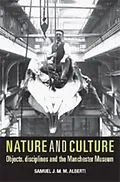This is a vital new work; the first to take the University of Manchester's Museum as its subject. By setting the museum in its cultural and intellectual contexts, Nature and culture explores twentieth-century collecting and display, and the status of the object in the modern world. Beginning with the origins of the Manchester Museum, accounting for its development as an internationally renowned university museum, and concluding at its major expansion at the turn of the millennium, this book casts new light on the history of museums. How did objects become knowledge? Who encountered museum objects on their way to museums? What happened to collections within the museum? How did visitors use and respond to objects? In answering these questions, Nature and culture illuminates not only the history of one institution, but also contributes to wider discussions in the history of science, cultural history and museology.
Autorentext
Sam Alberti is Lecturer in Art Gallery and Museum Studies at the Centre for Museology and Research Fellow at the Manchester Museum, University of Manchester
Inhalt
List of figuresAcknowledgementsList of abbreviationsIntroduction: museum historiographiesI. Museums and disciplinesII. The lives of objectsNotes1. Prologue: the Manchester Natural History SocietyI. The Museum on Peter StreetII. Visitors and staffIII. Transfer and dissolutionNotes2. Nature: scientific disciplines in the museumI. Unified nature 18871910II. Expanding collections 191050III. Nature dislocated 195090IV. Conclusion: cultural cartography and the MuseumNotes3. Culture: artefacts and disciplinary formationI. Culture precipitated 18901927II. Nature and culture distinguished 192769III. Culture consolidated 196990IV. Conclusion: shaping disciplinesNotes4. Acquisition: collecting networks and the museumI. Foundation and empireII. The economy of donationIII. Value for money?IV. The museum and the fieldV. Transfers and loansVI. Conclusion: the politics of acquisitionNotes5. Practice: technique and the lives of objects in the collectionI. Preparing and conservingII. Recording and cataloguingIII. Storing and displayingIV. Conclusion: towards a history of museum practice6. Visitors: audiences and objectsI. Organising the visitorII. Educating the visitorIII. Town and gownIV. Involving the visitorV. The visitor experienceVI. Conclusion: expanding the history of museumsNotesConclusion: the museum in the twentieth centuryNotesList of ArchivesBibliography
